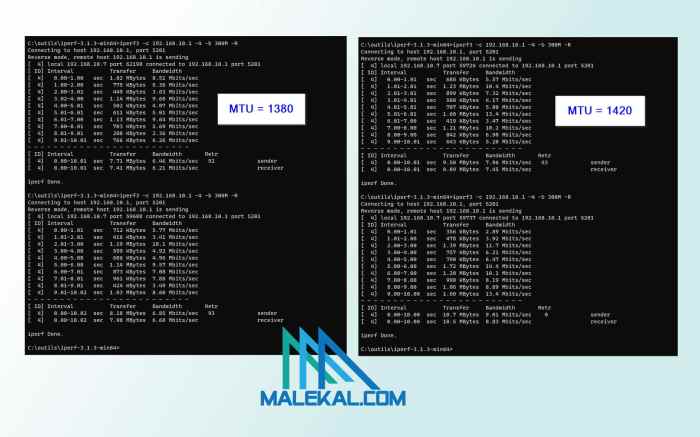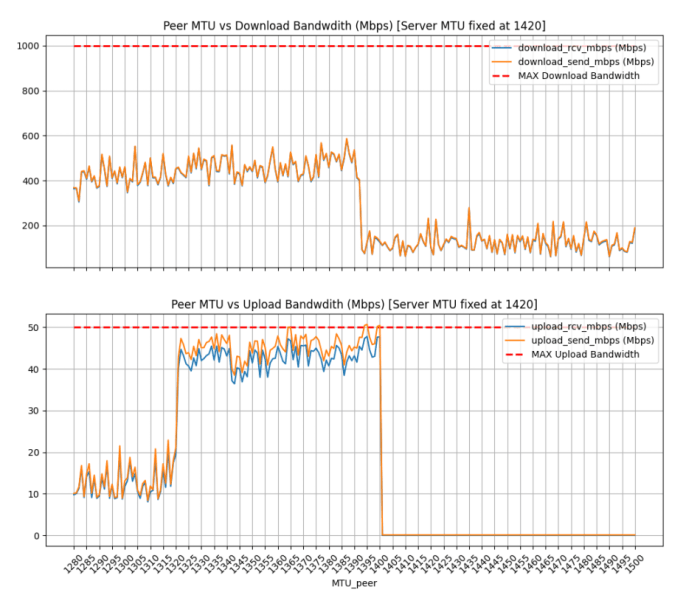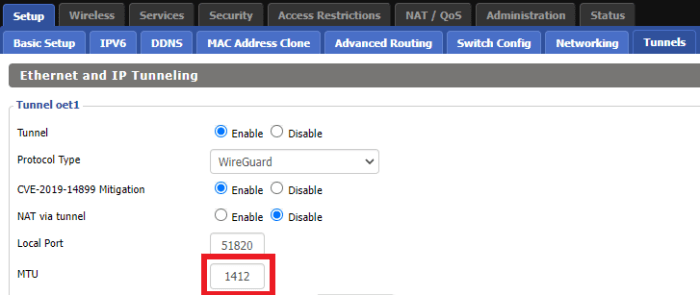In the realm of secure and efficient networking, WireGuard has emerged as a formidable contender. Its sleek design and lightweight implementation have made it a popular choice for VPNs, cloud computing, and network security. However, one crucial aspect that often goes overlooked is the Maximum Transmission Unit (MTU), a fundamental parameter that significantly impacts WireGuard’s performance and reliability.
This comprehensive guide will delve into the intricacies of WireGuard MTU, exploring its impact on network performance, packet fragmentation, troubleshooting, and security. By understanding the nuances of MTU, you can optimize your WireGuard configurations and unlock the full potential of this cutting-edge networking technology.
WireGuard MTU
WireGuard’s MTU, or Maximum Transmission Unit, is a crucial factor that affects the performance and efficiency of the VPN tunnel. It determines the maximum size of packets that can be transmitted over the WireGuard connection. Understanding and optimizing the MTU setting is essential for ensuring optimal performance.The
default MTU value in WireGuard is 1420 bytes, which is smaller than the standard Ethernet MTU of 1500 bytes. This is done to accommodate various network environments, including those with overhead from additional encapsulation or encryption layers. However, in some cases, increasing the MTU can improve performance by reducing packet fragmentation and overhead.
Impact of MTU on WireGuard Performance
The MTU setting has a direct impact on WireGuard’s performance in several ways:
-
- -*Packet Fragmentation
When packets exceed the MTU size, they are fragmented into smaller packets. This process introduces additional overhead and can slow down the transmission. Increasing the MTU can reduce fragmentation and improve performance.
- -*Packet Fragmentation
-*Network Overhead
Each packet carries a certain amount of overhead, such as headers and trailers. By increasing the MTU, more data can be packed into each packet, reducing the overhead per byte transmitted.
-*Latency
Higher MTU values can reduce latency by transmitting larger packets less frequently. This is especially noticeable in high-latency environments.
Adjusting WireGuard MTU
Adjusting the Maximum Transmission Unit (MTU) in WireGuard can optimize network performance and prevent packet fragmentation.
Follow these steps to modify the MTU:
- Edit WireGuard configuration file: Locate the WireGuard configuration file (typically named “wg0.conf”) and open it using a text editor.
- Set MTU value: Add or modify the “MTU” parameter to the desired value. The default MTU for WireGuard is 1420, but it can be adjusted to match the underlying network interface’s MTU.
- Save and restart: Save the configuration file and restart the WireGuard service to apply the changes.
Considerations for MTU Value
When choosing an MTU value, consider the following factors:
- Network interface MTU: The WireGuard MTU should be equal to or less than the MTU of the underlying network interface to prevent fragmentation.
- Path MTU discovery: WireGuard supports path MTU discovery (PMTUD), which automatically adjusts the MTU based on the network path. Enable PMTUD for optimal performance.
- Fragmentation: Using an incorrect MTU can result in packet fragmentation, reducing network performance and increasing latency.
Consequences of Incorrect MTU
Using an incorrect MTU can have several consequences:
- Packet fragmentation: Incorrect MTU can lead to packet fragmentation, causing performance issues and latency.
- Connection failures: Packets larger than the MTU may be dropped, resulting in connection failures.
- Reduced performance: Fragmentation and dropped packets can significantly reduce network performance.
MTU and Fragmentation
In computer networking, the maximum transmission unit (MTU) defines the largest size of a data packet that can be transmitted over a network interface. When a packet exceeds the MTU of the network interface, it must be fragmented into smaller packets before it can be transmitted.
Fragmentation can have several advantages and disadvantages:
Advantages of Fragmentation
- Improved network performance: Fragmentation can help to improve network performance by reducing the number of packets that are dropped due to exceeding the MTU.
- Increased reliability: Fragmentation can also help to increase the reliability of network transmissions by reducing the chance of packet loss.
Disadvantages of Fragmentation
- Increased overhead: Fragmentation can increase the overhead of network transmissions by adding additional headers to each fragment.
- Reduced efficiency: Fragmentation can also reduce the efficiency of network transmissions by requiring the receiver to reassemble the fragments into a complete packet.
Avoiding Fragmentation Issues
There are several ways to avoid fragmentation issues:
- Configure the MTU: The MTU can be configured on both the sender and receiver to ensure that packets do not exceed the MTU of the network interface.
- Use path MTU discovery: Path MTU discovery is a protocol that can be used to automatically discover the MTU of a network path.
- Use a fragmentation-aware application: Some applications are aware of fragmentation and can automatically fragment packets before transmitting them.
MTU and Network Performance
Maximum Transmission Unit (MTU) plays a crucial role in determining the efficiency and performance of a network. It directly impacts factors such as latency and throughput, influencing the overall user experience.
MTU defines the maximum size of a data packet that can be transmitted over a network interface. When packets exceed the MTU, they are fragmented into smaller segments, which can introduce additional overhead and latency.
Optimizing MTU for Better Performance
Optimizing MTU involves finding the largest possible value that can be used without causing excessive fragmentation. A larger MTU allows for more data to be sent in each packet, reducing the number of packets and the associated overhead. This can lead to improved throughput and reduced latency.
- Measure MTU: Use tools like ping or traceroute to measure the current MTU and identify any potential issues.
- Adjust MTU: Adjust the MTU on network interfaces to match the optimal value. This can be done through network configuration tools or command-line interfaces.
- Monitor Performance: Continuously monitor network performance after adjusting the MTU to ensure optimal performance and identify any potential bottlenecks.
MTU and Path MTU Discovery

Path MTU Discovery (PMTUD) is a mechanism used to determine the maximum transmission unit (MTU) along a network path. It ensures that packets are fragmented before being sent if they exceed the MTU of any link along the path. This helps prevent packet fragmentation and reassembly issues, which can degrade network performance.In
WireGuard, PMTUD is enabled by default. It uses the ICMPv6 Fragmentation Needed message to negotiate the MTU with the remote endpoint. If a packet is too large for the path MTU, the remote endpoint will send an ICMPv6 Fragmentation Needed message back to the sender, indicating the maximum MTU that can be used.
The sender will then fragment the packet accordingly.
Enabling and Configuring PMTUD
PMTUD is enabled by default in WireGuard, but it can be disabled or configured using the following settings in the WireGuard configuration file:* MTU : Sets the MTU for the WireGuard interface.
Fragmentation
Enables or disables fragmentation.
MTU and Network Troubleshooting
MTU plays a critical role in troubleshooting network issues. Understanding how MTU affects network performance and how to identify and resolve MTU-related problems can significantly improve network stability and performance.
Identifying MTU-Related Problems
MTU-related problems often manifest as slow network speeds, frequent packet fragmentation, or dropped connections. To identify potential MTU issues, consider the following symptoms:
Excessive packet fragmentation
Ping commands with the “-f” option can reveal high fragmentation rates, indicating an MTU mismatch.
Slow network performance
If the MTU is set too low, it can result in excessive packet fragmentation, slowing down network throughput.
Dropped connections
An MTU that is too large can cause packets to be dropped due to exceeding the maximum packet size allowed by the network.
Troubleshooting MTU Issues
To resolve MTU-related problems, follow these steps:
Test the current MTU
Use the “ping
-
- M do
- s 1472
- c 10″ command to determine the current MTU and identify any fragmentation issues.
Adjust the MTU
If the MTU is too low, increase it incrementally by 32 bytes until fragmentation is minimized. If the MTU is too high, decrease it until packet loss is eliminated.
Verify the MTU setting
After adjusting the MTU, use the “ping
- M do
- s 1472
- c 10″ command again to verify the new MTU and ensure there is no fragmentation.
Common Troubleshooting Scenarios
-*Scenario 1
Slow network speeds
Identify excessive packet fragmentation using the ping “-f” option.
-
- Adjust the MTU incrementally until fragmentation is minimized.
-*Scenario 2
Dropped connections
Determine if the MTU is too large by observing packet loss during file transfers or other data-intensive tasks.
-
- Decrease the MTU until packet loss is eliminated.
-*Scenario 3
Multiple network devices
Ensure that the MTU is consistent across all network devices to avoid fragmentation and dropped packets.
Use the “ip link set mtu ” command to adjust the MTU on each device.
MTU and Virtual Private Networks (VPNs)

MTU plays a critical role in VPNs, as it determines the maximum size of data packets that can be transmitted over the VPN connection. An appropriately configured MTU ensures optimal VPN performance and reliability, minimizing packet fragmentation and potential performance issues.
When the MTU is too large, data packets may exceed the maximum size allowed by the underlying network, leading to fragmentation. Fragmentation occurs when a large packet is broken into smaller fragments to be transmitted. This process can introduce additional overhead and reduce network performance.
Conversely, if the MTU is set too low, it can result in inefficient use of network resources, as smaller packets require more overhead to transmit.
Optimizing MTU for VPN Use
To optimize MTU for VPN use, it is essential to determine the optimal MTU value for the specific VPN connection. This can be achieved through path MTU discovery (PMTUD), a mechanism that automatically adjusts the MTU based on the maximum size of packets that can be transmitted without fragmentation.
PMTUD is supported by most modern operating systems and VPN software. It works by sending probe packets of increasing size until it encounters fragmentation. The MTU is then set to the size of the largest probe packet that was successfully transmitted without fragmentation.
In addition to PMTUD, manual MTU adjustment may be necessary in certain cases. This can be done by configuring the MTU setting in the VPN client software or on the VPN server. It is important to note that the optimal MTU value may vary depending on the underlying network infrastructure and the specific VPN technology being used.
MTU and Cloud Computing
MTU plays a crucial role in cloud computing environments, where applications and services are hosted on remote servers accessed over the internet. Understanding and managing MTU is essential to ensure optimal network performance and avoid potential connectivity issues.
Challenges and Considerations
Managing MTU in the cloud introduces several challenges and considerations:
-
- -*Virtualization
Cloud environments often involve virtualization technologies, which can add additional layers of network infrastructure. Each layer may have its own MTU settings, leading to potential MTU mismatch issues.
- -*Virtualization
-*Dynamic Environments
Cloud environments are highly dynamic, with instances and networks being created and terminated frequently. This can make it difficult to manually configure and maintain MTU settings.
-*Diverse Network Paths
Cloud-based applications may traverse various network paths with different MTU requirements. Managing MTU across these diverse paths is essential for reliable connectivity.
MTU and Network Security
The maximum transmission unit (MTU) can have security implications in network communication.
Understanding these implications is crucial for maintaining a secure network infrastructure.
An attacker can exploit MTU settings to launch various security attacks, such as fragmentation attacks and path MTU discovery attacks. Fragmentation attacks involve breaking down large data packets into smaller fragments that can bypass security measures designed to detect malicious payloads.
Path MTU discovery attacks, on the other hand, allow attackers to determine the MTU of a network path, which can be used to craft packets that are specifically designed to exploit vulnerabilities in network devices.
Recommendations for Securing MTU Configurations
- Configure MTU settings appropriately based on the underlying network infrastructure and applications.
- Use consistent MTU settings across all network devices to avoid fragmentation and ensure optimal performance.
- Implement path MTU discovery mechanisms to automatically adjust MTU settings based on the network path.
- Monitor network traffic for unusual fragmentation patterns that may indicate security attacks.
- Consider using network security devices such as firewalls and intrusion detection systems (IDS) to detect and mitigate MTU-based attacks.
MTU and Future Developments
The future of MTU holds exciting possibilities as emerging technologies and advancements continue to shape the networking landscape. This section explores potential developments and trends related to MTU in WireGuard, examining their impact and providing insights into the future of MTU optimization and management.
One key area of development is the integration of AI and machine learning (ML) into MTU management. AI-driven algorithms can analyze network traffic patterns and dynamically adjust MTU settings to optimize performance. This automation can eliminate manual intervention and ensure optimal MTU configurations in real-time.
Path MTU Discovery
Another area of focus is the advancement of path MTU discovery mechanisms. New protocols and techniques are being developed to improve the accuracy and efficiency of MTU discovery, reducing the likelihood of fragmentation and ensuring smooth data transmission.
Jumbo Frames
The use of jumbo frames, which are larger than standard Ethernet frames, is gaining traction. Jumbo frames can accommodate more data in each packet, reducing the overhead associated with fragmentation and improving network efficiency. However, support for jumbo frames requires compatibility across all network devices.
Closing Summary

Mastering WireGuard MTU is an essential skill for network engineers, administrators, and security professionals alike. By adjusting MTU values appropriately, you can minimize latency, reduce fragmentation, enhance throughput, and ensure seamless connectivity. Remember, a well-tuned MTU configuration is the key to unlocking the full potential of WireGuard and maximizing your network’s performance and reliability.